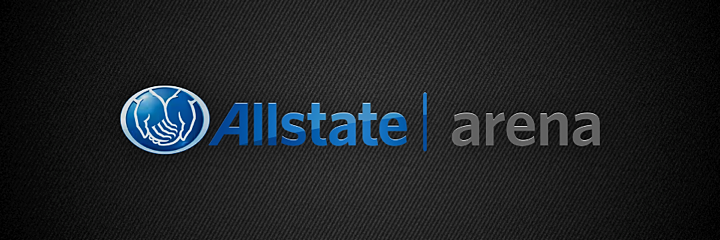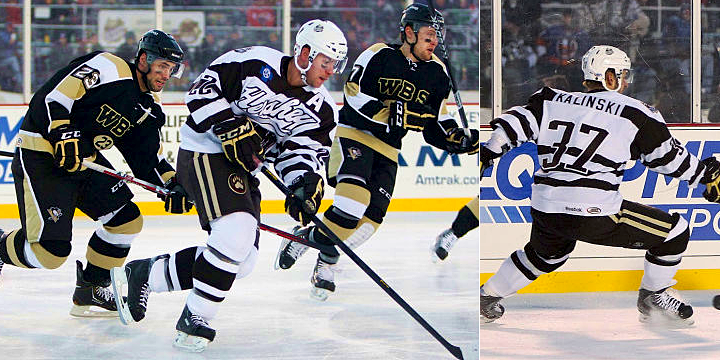Arena Logos: The AHL West
 Sunday · Feb 10 · 2013 | 12:32 PM PST
Sunday · Feb 10 · 2013 | 12:32 PM PST  5 Comments
5 Comments Two weeks ago, I put NHL arena logos on display just for fun. This weekend, we're taking a look at what the AHL has to offer in this area. Yesterday, it was the rink in the Eastern Conference. Today, the Western Conference. Enjoy.

Abbotsford Entertainment & Sports Centre opened in 2009 in Abbotsford, B.C. — and just a few months later, it became home to the Abbotsford Heat. The Heat are the latest incarnation of a franchise that has been rather nomdic over past decade, relocating every few years. After leaving Saint John, New Brunswick in 2003, the club played in Omaha, Neb. and Moline, Ill. before arriving in British Columbia.

The Time Warner Cable Arena was built for the NBA. In fact, when it opened in 2005, it was called the Charlotte Bobcats Arena. But back then, the Charlotte Checkers were an ECHL franchise and shared the arena with the Bobcats. That team was dissolved in 2010, however, when the AHL's Albany River Rats moved to North Carolina and assumed the Checkers nickname. Time Warner Cable bought the naming rights in 2008 and changed the logo as part of a 2010 corporate rebranding.

Located in Rosemont, Ill., just outside of Chicago, is Allstate Arena — known as Rosemont Horizon from its opening in 1980 until 1999. It's been home to the Chicago Wolves since their entry into the International Hockey League in 1994. The Wolves transferred to the AHL when their original league went belly up in 2001.

The story of Van Andel Arena in Grand Rapids, Mich. is not unlike that of Allstate Arena. It began life in 1996 housing IHL hockey in the form of the Grand Rapids Griffins. Like the Wolves, the Griffins joined the AHL in 2001 where they still play today.

Copps Coliseum has hosted Hamilton Bulldogs hockey for the past 20 years. But it hasn't always been the same franchise. The original Bulldogs arrived from Sydney, Nova Scotia in 1996 but left in 2002 to become the Toronto Roadrunners. However, at the same time, the Quebec Citadelles moved in and became the new Bulldogs. So as far as fans are concerned, their team hasn't missed a beat.
But there's a pre-Bulldogs history to include. The Coliseum opened in 1985 where it hosted OHL junior teams until 1991. The AHL's Hamilton Canucks were formed in 1992 but moved to Syracuse, N.Y. after only two seasons. The Bulldogs entered the picture two years after that.

There's a bit of trouble brewing at Toyota Center in Houston, Texas. At the end of this season, the lease is up for the Houston Aeros and negotiations for a new one are not going well, according to the Houston Chronicle. No decisions have been made yet, but if a deal isn't done, it could spell the end of a long run of minor league hockey in Houston.
The Aeros were founded in 1994 in the IHL and joined the AHL in 2001. Since 2003, they've played at Toyota Center, which is operated by the NBA's Houston Rockets. They are the building's primary tenant.

I'm sure you're noticing a lot of Western Conference AHL teams sharing buildings with the NBA. The Lake Erie Monsters are another example, as they've split time at Quicken Loans Arena with the Cleveland Cavaliers since 2007. The Q opened in 1994 as Gund Arena, housing the Cavaliers and the IHL's Cleveland Lumberjacks. The Jacks did not survive the dissolution of the league in 2001, but were immediately replaced by the AHL's Cleveland Barons — who moved from Lexington, Kentucky. They then moved to Worcester, Mass. in 2006.

Another story you've heard a few times before in this post with just a few names changed. The BMO Harris Bradley Center (just the Bradley Center prior to the 2012 naming rights purchase by BMO Harris) houses the AHL's Milwaukee Admirals as well as the NBA's Milwaukee Bucks. It opened in 1988 with both of these teams as founding tenants — though the Ads were members of the IHL at the time.

The Cox Convention Center opened in 1972 as "The Myriad" and has hosted numerous hockey teams over the years. The Oklahoma City Blazers of the Central Hockey League did two stints, 1973—1977 and 1992—2002 and there was even a season of roller hockey in 1995 — the Oklahoma Coyotes. However, since 2010, the Oklahoma City Barons have been the prime resident.

The Peoria Civic Center is part of a complex that includes Carver Arena, home to the Peoria Rivermen since arriving from Worcester, Mass. in 2005. But the Civic Center opened in 1982 and has always hosted some form of pro hockey. The Peoria Prancers were founded in 1982 and changed their name to Rivermen in 1984. In 1996, they moved to San Antonio, Texas but were replaced by a new ECHL team, also called the Rivermen, until the 2005 arrival of the AHL.

In downtown Rochester, N.Y., you'll find Blue Cross Arena at the War Memorial. Don't let the glass façade fool you; it was built in 1955 but got a major renovation in 1998 when Blue Cross picked up the naming rights. In all that time, it's been home to the Rochester Americans.

Look familiar? BMO Harris Bank owns the naming rights to not one, but two AHL rinks. Along with the Bradley Center in Milwaukee is BMO Harris Bank Center in Rockford, Ill. The arena opened in 1981 but didn't host hockey until 1999 when the UHL's Rockford IceHogs were founded. They went out on top, winning the 2007 UHL championship before being replaced by the AHL. The Cincinnati Mighty Ducks franchise had been re-established but failed to meet a season ticket sales goal, so the team relocated to Illinois and adopted the IceHogs moniker.

The AT&T Center opened in 2002 as the new home of the NBA's San Antonio Spurs, but at the same time, earned the city a brand new hockey team. The dormant Adirondack Red Wings franchise was re-established in Texas as the San Antonio Rampage.

One of the newer arenas in the AHL is the Cedar Park Center in Cedar Park, Texas — home of the Texas Stars. The Stars were the building's founding tenant and its reason for being built. Prior to 2009, the club was based in Des Moines, Iowa, first as the Iowa Stars, and later the Iowa Chops.

And finally, the Toronto Marlies have called Ricoh Coliseum home for all of their eight years of existence. But the building itself has been around since 1921! It was renovated in 2003 and its first tenant was the Toronto Roadrunners, who the Edmonton Oilers had just moved out of Hamilton, Ont. The NHL club then moved their affilate geographically closer to them (to Edmonton) the following season and suspended operations a year after that.
The Marlies moved from St. John's, Newfoundland in 2005 after a season without hockey at the Coliseum. The arena was formerly known as Civic Arena and CNE Coliseum prior to Ricoh buying the naming rights in 2003 after the renovation.
Hope you found these posts at least half as interesting as the NHL arena posts.
 Chris
Chris
A couple AHL relocations for the 2013-14 season means a couple new arenas to add to this post.

After failing to get a new contract at the Toyota Center, the Houston Aeros left town. They headed north for Des Moines, Iowa where they became the Iowa Wild and will begin playing home games at Wells Fargo Arena, a venue that's part of the Iowa Events Center.
The arena opened in 2005 with Iowa Stars as a primary tenant. That team was renamed the Iowa Chops in 2008 when they signed an affiliation deal with the Anaheim Ducks. A year later, the franchise linked up with Dallas again and moved to Cedar Park leaving Des Moines without any AHL action for the last five years.

After the Vancouver Canucks purchased the Peoria Rivermen, they decided Illinois wasn't for them. The team moved to Utica, N.Y. and became the Utica Comets this summer. They will play at the Utica Memorial Auditorium beginning this fall. And to mark the occasion, The Aud is undergoing a bit of a rebranding — as well as some renovations. This new logo is in the process of being implemented.
The 63-year-old building has hosted a number of minor league hockey teams in its time, but the last AHL game took place 20 years ago before the Utica Devils left in 1993.
By the way, weird coincidence that both these logos use the same font.
Anyone know if any AHL arenas have been renamed or rebranded in the last six months?



































